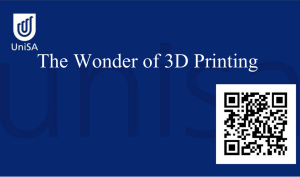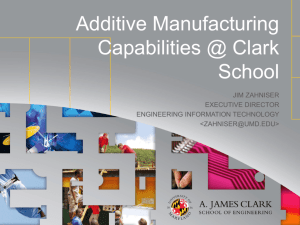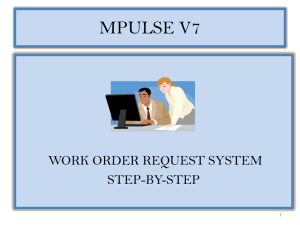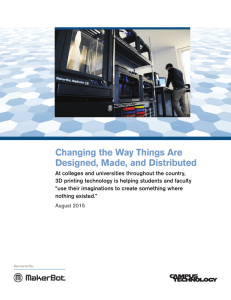Document
advertisement
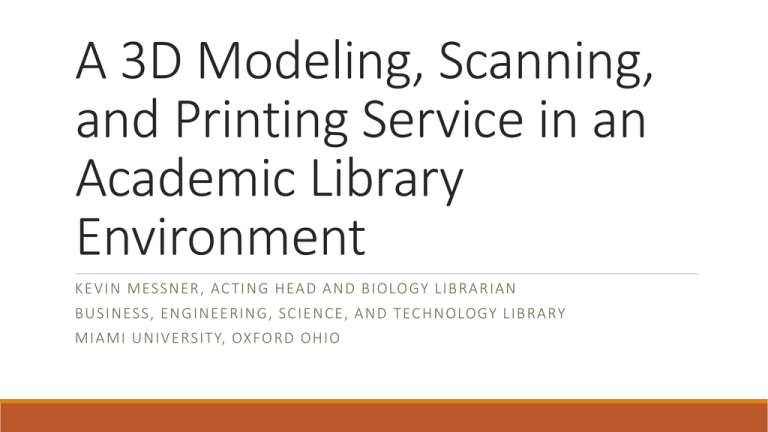
A 3D Modeling, Scanning, and Printing Service in an Academic Library Environment K E V I N MES SNER , AC T I N G HEA D A N D BI OLOGY L I BR A R IAN BUS I N ESS, E N G INEERING, S CI E NCE, AN D T ECHN OLOGY LI BR ARY M I A MI UN I V ERSITY, OX FOR D OHI O Overview, Intent and Outcomes I. Overview of the technologies II. Our implementations and experiences at Miami U Libraries Goals: Learn some major considerations of a 3D printing program; inform whether this is a service/program you want to further explore, initiate, or expand Getting a read on the audience 1. Raise a hand if you have seen a 3-D printer work before. 2. Raise a hand if you have a 3-D printer in your library workplace. 3. Raise a hand if you are involved in operating that printer. 4. What type of library do you work in? Public? Academic? Other? Overview of 3-D Printing Historical perspective: 3-D printing as a concept, first machines in the 1980’s By 2000, specialty commercial/industrial printers in many markets (e.g. in orthodontics) Mid-’00’s, Broad adoption in design industry (but “entry level” price point still $40K+, cabinetsize) Late ‘00’s, desktop-scale DIY/hobbyist machines such as RepRap 2012, MakerBot Replicator breaks the $2K price point 2012-14 Proliferation of hobbyist-level FDM printers, other technologies in the sub-$5K range AutoDesk joins the 3D printer wars: http://www.cnet.com/news/autodesk-joins-the-3d-printer-wars/ MakerBot Replicator - FDM (fused-layer deposition modeling) technology: At core, a robot-controlled glue gun - uses ABS (“Lego”) or PLA (polylactic acid) plastic - plastic filament fed into heater-extruder, melted, deposited onto build plate - Miami U Libraries acquires two machines in summer 2012, opened service as “soft rollout” during fall 2012 Demo Videos http://www.youtube.com/watch?v=8_vloWVgf0o Zcorp Spectrum Z510 Printer - Miami Dept of Mechanical and Manufacturing Engineering acquired printer in 2009 - Mothballed by 2011 after intermittent use ◦ “no one in charge” – maintenance, troubleshooting issues ◦ little knowledge of availability even to undergraduates in dept - Early 2013, proposal to move to Libraries, move and overhaul in early fall - Prints using gypsum-based powder and cyanoacrylate-based binder - Full-color printing - No supports needed, professional-looking product - Parts print 100% solid (unless cavity designed into model) - Parts more fragile, more heft, much more expensive than plastic parts Demo Videos http://www.youtube.com/watch?v=R-JOJ91p9Wc Many other 3D printing technologies Stereolithography – laser-catalyzed deposition of particles from liquid (e.g. Form1) Lamination – layers from paper or plastic sheets (e.g. Mcor Iris) And others… NextEngine 3D Scanner - Acquired by Miami U. Libraries 2009, moved to B.E.S.T. Library 2011 - Can handle wide range of object size, we’ve done tabletop miniatures up to a full-sized coffin - Three on MU campus, limiting skill set is process of “stitching” multiple scans together into a single image - As with printing, there are many other products and approaches to 3D scanning, e.g. photogrammometry http://www.fox19.com/story/24962811/miami-university-using-3-d-printing-technology Motivation Why get into this field as an academic library? -Potential for integration into classroom, e.g. learning and demonstration objects, visualization of difficult concepts; student design projects -Libraries handle shared resources well; bring technology into public, equitable, open space where it can be widely available, accessible, approachable. -In pre-online age, users came to library to copy journal articles; our ambition is researchers will routinely come to the library to “copy” machine components, protein molecules, art, etc., from our digital information resources Miami U Overview ~16,000 students on main campus in Oxford Ohio Traditionally considered a “liberal arts” university, but nationally recognized business school and education college, rapidly growing engineering college (1000 students) Graduate programs in selected areas, Ph.D. programs in Biology, Microbiology, Chemistry, Geology, Psychology, English, Education Our Experience at Miami Issue #1: Who’s Gonna Do This? - Personnel and staffing have grown with the service: - Started with one technician working with printer at about 25% FTE; cooperation with staff person at main library running their printer in technology lab - First two months spent experimenting, testing what was doable, troubleshooting issues with the machine; all this was done in public space (computer lab) in sight of patrons - Soft rollout during Fall 2012 semester, never made coordinated promotions push - That tech’s time commitment has since increased to about 67% FTE with addition of 2nd MakerBot, Zcorp machine. Maintenance of the machines is a major use of time - Additionally have trained another technician who devotes about 25% FTE during peak times, a graduate assistant to run and monitor prints, two undergrads in different capacities; and I will run prints as needed - Time commitment depends on ambition: background of staff; tricky prints, expectations of turnaround time influence time commitment from staff Staff Qualifications - Primary technician is a former Navy Petty Officer, also my GIS technician - (former) CIM Lab Manager B.S. in Computer Science - Secondary technician has a M.S. in Music Technology - Graduate assistant in Software Engineering M.S. program - Undergraduate major in Mechanical Engineering - Undergraduate majors in Interactive Media, A.A. in Digital Art (With a doctorate in microbiology and an MSLIS, I’m the least qualified operator of the bunch) “Behind the Glitz and Glamour” - MakerBots require a lot of monitoring and “hand-holding” - Starting a job from importing file to takes at least 20’. - First machine ran well initially then got less reliable - Second machine ran poorly initially, retuned and eventually was acceptable -High failure rate; can’t leave unattended, don’t run overnight. (get a webcam for ‘remote’ monitoring from desk) - Have rarely had luck with two-color prints -Slow, prints take many hours, start first thing in the morning and cross fingers - Bigger the part, exponentially higher risk of failed print “Behind the Glitz and Glamour” - Breakdowns frequent, have had to tear down each machine at least twice, replace various electronic and mechanical components - Both MakerBots purchase mid-2012 have come to end of life cycle as of spring 2014. (Multiple component failures.) - Replicator 2X has been somewhat more reliable though not trouble-free. - Looking to move on to industrial-quality printers: need larger build space, better reliability, better quality/precision of product - MakerBots served their purpose to pilot the service, proof of need on campus, and we ran them long, hard, and mercilessly. ◦ But do not consider them an effective value long-term, especially when cost of staff time in maintenance and hand-holding considered Customer Service and Expectations; “Training the Client” Setting realistic expectations on: - turnaround time (our ideal is 2 days; some jobs have taken 2 months) - quality of product: tolerances, fit of pieces, level of detail possible - right angles, piece fit (Ironically, printing a box with a fitting lid is one of our greater challenges.) - points to need for other fabrication technologies, e.g. a simple CNC router; down the road, a laser cutter - pushing the build envelope; size capacity Some things just will not print, but we do not currently charge for failed prints so no disincentive to try over and over. We reserve right to turn down jobs we do not have capacity for. Customer Service and Expectations; “Training the Client” Not a “dry cleaner” shop. The average job requires a fair amount of communication and consultation needed for success. Not instant gratification, not guaranteed success Problematic designs are the norm, e.g. - “holes” in framework where pieces don’t meet - scaling (e.g. cargo container) - non-connected pieces (looked like one piece on the screen) - impossibly light/fragile designs Walk-up/self-service printing – some libraries are pursuing this; we have not gone there, except with clients we know very well Pricing Service - Our mandate was to recover cost for consumable materials: plastic, gypsum powder, binder/ink solutions $0.25/gram charge. An “average” MakerBot job is $10, a typical Zcorp job is $30+. - Initially did not include cost of plastic support material, charged for finished/cleaned-up part only. - Now do this case-by-case, charge where support material is significant - We are NOT recovering cost on staff time, original cost of machines or major repair/replacement part costs* Location, Location, Location: Where to Place? - Printers at two libraries, on opposite sides of campus - MakerBots located on desktops, in highly visible working spaces (library computer labs) from Day 1 – wanted service to be visible, not “hidden in a closet” - This has definitely helped with promotion and awareness of the service, people stop to look and ask questions - Makes some noise but haven’t had complaints - Display of parts around the facilities - Campus Environmental Health and Safety had no concerns, “office-appropriate” -Zcorp machine is kept in a closed room – some odors, powder dust (again no concerns from EHS), printer is relatively loud and vacuum cleaner used to clean parts very loud Other Considerations for Locations We have noticed MakerBots can be sensitive to ambient temperature, drafts, humidity, sunlight, so take caution in placement Collaborations Interactive Media Studies/Visualization Center: CAD/modeling design assistance, holographic projector display of design projects Mechanical Engineering: partnership on Zcorp machine*, co-mentorship of FYRE student; major client for student design projects Dept of Anthropology: archaeologist faculty member is our expert on scanning technology, taught us (also a major user and promoter of our services) Lane Library: local public library also running MakerBot machines, trading tips and experience; referrals FYRE student performed material strength test project, helping answer questions about suitability of our output for certain applications Beyond Printing: Scanning, Modeling, Service Workflow Multiple starting points and end points for projects: data file (GIS, PDB) CAD model design concept CAD model repair, resize, printability extant object scan How are We Doing? Anticipated certain potential use types, motivations for the service: -Potential for integration into classroom, e.g. learning and demonstration objects, visualization of difficult concepts; student design projects - Libraries handle shared resources well on a campus; bring technology where it can be widely available, accessible, and approachable. - First foray into library as “makerspace” for our university community -In pre-online age, users came to the library to copy journal articles; researchers will routinely come to the library to “copy” machine components, protein molecules, art, etc. And, The Unexpected Uses/Users - Community engagement – schools, scouting groups, Chamber of Commerce, media* - Inquiries from companies (engineering firms, marketing) - Inquiries from University of Miami (FL)… - sculptor - “need 50 of these” -- line between customized “one-off” production and mass production? “So what’s the least I need to start a service?” I have been asked this question several times. Obviously it depend on your ambitions, clientele needs, etc. But IMO, to start a baseline service with a hobbyist level machine you need: - a FDM printer, e.g. MakerBot 5th Gen (Consider Competitors!!) - access to design software, e.g. AutoDesk products, OpenSCAD, SketchUp Pro*, TinkerCAD, blender.org. (Even Photoshop can be used for very simple objects. Thingiverse as source of “predesigned” files.) - one technically-oriented staff person who can devote a baseline of 1/4-1/3 of their time to learning, operating and maintaining the printer; a second staff person who is capable of and has flexibility to at least run and monitor jobs as needed
